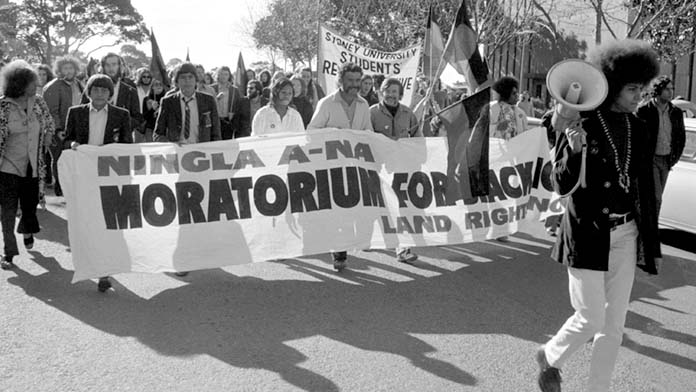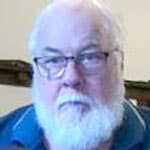The Black Moratorium marches held on 14 July 1972 saw thousands take to the streets around the country in the largest demonstrations in support of Aboriginal rights up to that time. There were protests in Darwin, Adelaide, Melbourne, Sydney, Canberra, Brisbane and NSW regional centres. In Sydney thousands of building workers, ship painters and dockers and teachers took a half-day strike to attend, with the demonstration held on a weekday.
Bob Makinson was involved in organising meetings in Sydney as a high school student. He spoke to Solidarity about the marches and their part in the history of the Aboriginal rights movement.
The Black Moratorium marches in 1972 followed a period of major struggles around the Vietnam War, the beginnings of the Women’s Liberation movement and important trade union struggles. Could you talk a bit about how that context fed into the Black Moratorium?
Those background issues meant that left and progressive sections of society were mobilized at an electoral level, to some extent industrially, but especially in terms of street protests of one sort or another. That became the popular form of expression for issues. Vietnam was certainly important, in that there were very large numbers of people mobilised and comfortable with the demonstration format.
The industrial situation and the mobilisation of Labor party elements towards an election victory, which didn’t come until 1972, meant that there was a receptivity in the trade unions to social issues.
The year before the Black Moratorium, there was the tour of the South African Springboks rugby team. South Africa at that time was an apartheid state. Large mobilisations against that rugby tour in several cities around Australia had helped to forge an effective alliance across all sorts of boundaries.
Towards the end of the Springbok tour Aboriginal activists were able to say, it’s all very well to be protesting about what’s happening in South Africa, but have you looked at what’s happening in Australia?
Quite a number of people took notice of that and in the following six to 12 months a lot of activity started to occur around solidarity with Aboriginal demands.
Was the establishment of the Aboriginal Tent Embassy earlier in 1972 important in the call for the Black Moratorium?
It was hugely important and in many ways, in terms of the long-term history of the Aboriginal struggle, that was more important than the Black Moratorium demonstration itself, as were a number of other developments.
A group of radical mostly young Aboriginal activists largely in Sydney, but also in Brisbane and a few other centres, had been looking at the Black Panthers in the United States—not just their political actions, but also the community level organising, and the foundation of the Aboriginal Medical Service, the Aboriginal Legal Service, the breakfast for kids programs owed a lot to that.
The establishment of the Tent Embassy in early 1972 was a direct response to a statement by the Liberal government of the day and Prime Minister Billy McMahon that effectively declared that it would never consider land rights for Aboriginal people.
In a quite brilliant stroke overnight, the day before Australia Day, or Invasion day as we now call it, a small group of Aboriginal activists seized on that. Within 24 hours they got themselves to Canberra, and set up the Tent Embassy, initially under a beach umbrella.
It was an assertion of land rights as a central issue. In many ways the Black Moratorium was an expression of a fairly broad social alliance in support of the Tent Embassy and the land rights agenda, which was fairly new at the time.
What are your memories of how the Moratorium itself was organised and built, and of the protest on the day itself? How were you involved personally?
I was a high school activist at the time. I’d been involved in various Vietnam activities and in the Springboks demonstrations.
I went to the organising meetings for about five or six months in Sydney and I think I was the only high school student in the room most of the time.
A number of people in the anti-apartheid movement that had organised the Springboks actions the year before were exerting their networks to spread word about the planned demonstration and what it was about. Various trade unions were coming on board. You had Communist Party activists, including Denis Freney, who chaired most of those meetings and had been asked to do so by the Aboriginal participants.
The Communist Party was able to call on a lot of union support for the demonstration, sympathetic ALP members were able to do likewise. And you had networks through the universities largely built through Vietnam and the Springboks and we even had some networks in the High School area. The churches were important as well.
There was quite broad participation from people who were not of the left necessarily. Many of those had come in the previous year around the Springboks actions because of their disgust with the South African situation and had understood the call to bring the anti-racist struggle back home.
The organising meetings were also a snapshot of the generational change that was starting to happen among Aboriginal activists, with both older activists who were veterans of the 1967 referendum campaign and many other struggles, such as Pat Eatock and Chicka Dixon to name just two, and a new, younger group including Bob Bellear, Gary Foley, Paul Coe, and Bobbi (later Dr Roberta) Sykes, among others. There were pretty strong differences of approach but a common sense of purpose.
I remember one meeting where Gary Foley and one or two others were reporting back on an interstate trip and they said “We have something to show you all”. And they unwrapped a flag. It was the now well-known Aboriginal flag, that had been designed by Harold Thomas in Darwin, but which had not previously been shown in Sydney. Everybody knew that was a pretty special moment.
There were several Moratorium marches against the War in Vietnam in the years before 1972. What was the significance of the use of the term “Moratorium” and can you talk about the trade union participation in the march in Sydney?
Moratorium was a term which was first coined in the United States for a series of anti-Vietnam War demonstrations in 1969.
It was a direct import to Australia and applied from 1970 onwards to a number of major anti-Vietnam War mobilisations here. A moratorium means a temporary stoppage of activity and was about stopping normal civic and commercial activity in order to stop the war in Vietnam. Because those demonstrations mobilised so many people, they became familiar with the term and it became applied also to the Black Moratorium.
My recollection is that a number of building sites did stop work. Certainly there was a major trade union presence on the day.
The organising group had managed to get a lot of material either into trade union newsletters or into on-site meetings, prior to the event to help win trade unions on board.
What do you think the Black Moratorium and the Aboriginal rights struggles of the period achieved?
You’ve got to admire the breadth of conception that existed among the Black and white activists who were working on this at the time, particularly the Black Power group that existed in Redfern. Within a matter of months they mapped out an agenda for both asserting Aboriginal control, the development of solidarity activity, and of pursuing political objectives including land rights and getting that onto the national political agenda in a way that it simply hadn’t been previously.
And at the same time these same people were doing extraordinary work in the Sydney and Brisbane urban communities in building services like the legal service and medical service and also networking with people on what were still then Aboriginal reserves and in country towns. So they were working an agenda both to mobilise within the Indigenous communities, but they were also aware of the need for broader support from non-Indigenous communities and they knew what buttons to press to get people on board for that—demonstrations being one part of it, but symbolic actions like the Tent Embassy and higher level policy interventions another part.
They really mapped out a very comprehensive idea and the Black Moratorium demonstration was essentially part of their own autonomous scheme for mobilising support in one section of the non-Indigenous community, the left and progressive crowds that had been already mobilised around Vietnam and Springboks. The organisation of the Black Moratorium was to help solidify that support and to spread word about the new land rights agenda.
Listen to the full conversation with Bob Makinson below.







